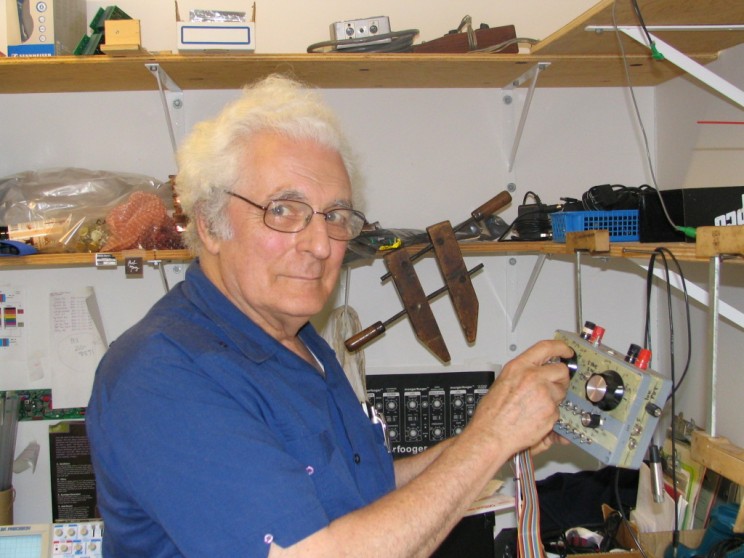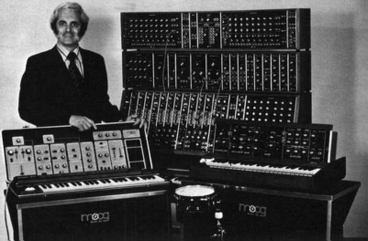It’s a cartoon image from my childhood: a man with wild hair, wearing a topcoat, and frantically waving a baton with a deranged look on his face. In fact, this caricature of what a composer should look like was probably inspired by the popular image of Beethoven: moody, distant, a loner… a genius lost in his own world.
The post Technology and the evolving portrait of the composer appeared first on OUPblog.
By Maggie Belnap
The invention of the synthesizer in the mid-20th century inspired composers and redesigned electronic music. The synthesizer sped up the creation process by combining hundreds of different sounds, and composers were inspired to delve deeper into the possibilities of electronic music.
1. Electronic music was first attempted in the United States and Canada in the 1890s. Its creation process was difficult. To create just a few minutes of music, with perhaps a hundred different sounds, could take weeks to finalize.
2. The first true synthesizer was released to the public in 1956. It was made up of an array of electronic tone generators and processing devices that controlled the nature of the sounds.
3. That synthesizer played itself in traveling patterns that could be repeated or not. It was controlled by a system of brush sensors that responded to patterns of pre-punched holes on a rotating paper roll.
4. The most well-known and celebrated electronic pieces in the 1950s are Eimert’s Fünf Stücke, Stockhausen’s Gesang der Jünglinge, Krenek’s Spiritus Intelligentiae Sanctus, Berio’s Mutazioni, and Maderna’s Notturno.
5. The first electronic concert was given in the Museum of Modern Art, NY on 28 October 1953 by Ussachevsky and Luening.
6. Two Americans, Robert Moog and Donald Buchla, created separate companies to manufacture synthesizers in the 1960s. Robert Moog’s synthesizer was released in 1965 and is considered a major milestone for electronic music.
7. They were followed by others and soon synthesizers that were voltage-controlled and portable were available for studio and on stage performances.
8. In the 1980s, commercial synthesizers were produced on a regular basis. Yamaha released the first all-digital synthesizer in 1983.
Maggie Belnap is a Social Media intern at Oxford University Press. She attends Amherst College.
Oxford Reference is the home of reference publishing at Oxford. With over 16,000 photographs, maps, tables, diagrams and a quick and speedy search, Oxford Reference saves you time while enhancing and complementing your work.
Subscribe to OUPblog via email or RSS.
Subscribe to only music articles on OUPblog via email or RSS.
The post Eight facts about the synthesizer and electronic music appeared first on OUPblog.

By Mark Vail
While I wasn’t born early enough to know Antonio Stradivari, Henry E. Steinway, or Adolphe Sax personally, I did see 95-year-old Leon Theremin from afar at an outdoor Stanford University concert on 29 September 1991. Not many people have the opportunity to meet in person, or speak on the phone with, someone who designed and built a special musical instrument. I have been fortunate to have many such experiences with pioneers of my favorite instrument, the synthesizer, along with those who have invented other products used in the field of electronic music.
Synthesizers first stole my interest as a senior in high school when I read an article by Wendy Carlos in 1973’s The Last Whole Earth Catalog. In the making of Switched-On Bach and other early albums, Carlos used a Moog synthesizer, so naturally I wanted one too. In late 1976 I bought my first synthesizer, a Minimoog — America’s best-selling analog synthesizer of the 20th century.
In January 1988, in my first assignment as a member of Keyboard magazine’s editorial staff, I flew to Anaheim to attend my first Winter NAMM show, the biggest music convention in the Western hemisphere. Music merchants introduce their latest instruments, dealers and store owners comb the exhibition booths for items to sell, and other interested attendees play instruments, gather documentation, and greet old friends.
On the first day of the four-day event, my new boss — Editor-in-chief Dominic Milano — asked me if I wanted to meet synthesizer pioneer Bob Moog. Who wouldn’t? Just before the introduction, I switched the cassette recorder in my shirt pocket into record mode. I’ve since lost that tape, but thankfully before he passed at the young age of 71 in August of 2005, I became good friends with Bob.
Bob wrote for several Keyboard columns, including one called “Vintage Synths.” His first appeared in the September 1989 issue, and it was appropriately about the Minimoog. This and subsequent columns fueled a fire of interest in a technology that had been mostly abandoned through much of the decade: analog synthesis. Bob wrote three more vintage columns over the next five months then, following his January 1990 column on E-mu’s early lineup of modular synths, told Dominic that he preferred looking forward into the future instead of toward the past. Wonder of wonders, the “Vintage Synths” column fell right into my lap. I consider that one my luckiest days because it turns out that writing about old stuff – even if considered obsolete by some – never goes out of style.
Years later, in July 2004, I had the great fortune to visit and spend a few days with Bob in Asheville, North Carolina. During the tour through the Moog Music office, I spotted an odd device with knobs and jacks sitting on a shelf and asked Bob what it was. He said he didn’t know, but grabbed and posed with it.

Synthesizer pioneer Bob Moog poses with an unknown device in the Moog Music office in July 2004. Photo courtesy of Mark Vail.
Many NAMM attendees yearned to meet Bob Moog, especially after he had legally recovered the right to use his own name on musical instruments again in 2002 and developed a Minimoog for the 21st century, the Voyager. During the January 2005 convention, two friends and I were determined to have dinner with Bob, but we more or less had to kidnap him from the Moog Music booth where dozens were waiting for his autograph. We had to convince several of the autograph seekers to return on Sunday to meet Bob, and quickly whisked him away from the scene.
The four of us—synthesists Amin Bhatia and Dave Gross, plus Bob and I—got into my car with no idea where we were going to eat. Our clueless excursion through Anaheim first took us past a flashy bordello, which Bob kiddingly said might be fun, before finding a quiet but festively painted Vietnamese restaurant where we enjoyed a wonderful dinner.

From left to right, author Mark Vail, synth pioneer Bob Moog, Seattle synthesist Dave Gross, and synthesist/composer Amin Bhatia. Photo courtesy of Mark Vail.
At the time, Amin Bhatia was working on an all-electronic version of Ravel’s “Bolero,” using a series of renowned vintage synthesizers and drum machines and he wanted Bob to introduce the piece with in a voiceover. Bob loved the early snippets of Amin’s music and was thrilled by the idea, but within a few months the news came that Bob was battling brain cancer, which eventually took his life on 21 August 2005. I dearly miss my brilliant and jovial friend Bob Moog, whose business card listed him as the Grand Poobah.
Building on his life-long interest in music, Mark Vail discovered synthesizers in 1973 and bought his first in 1976. After earning an MFA in electronic music in 1983, he served on the editorial staff at Keyboard magazine from 1988 to 2001. The author of Vintage Synthesizers, The Hammond Organ: Beauty in the B, and The Synthesizer, Mark is internationally acknowledged as a foremost authority on synthesizers.
Subscribe to the OUPblog via email or RSS.
Subscribe to only music articles on the OUPblog via email or RSS.
The post Mark Vail remembers synth pioneer Bob Moog appeared first on OUPblog.






